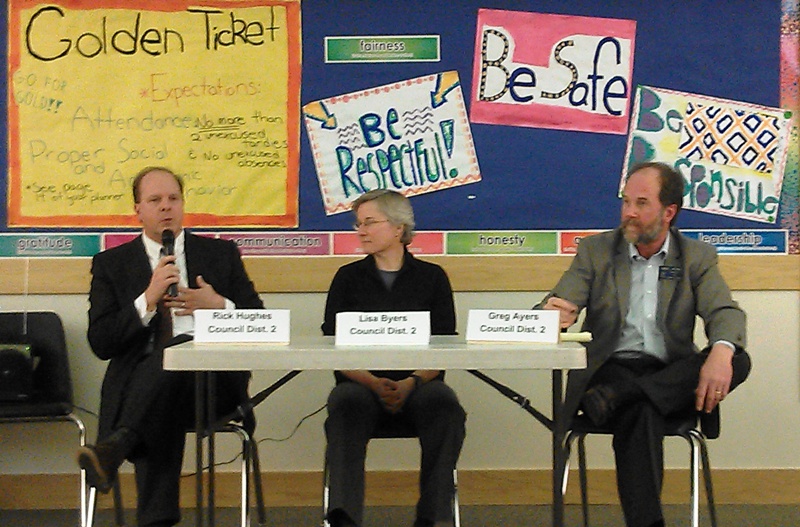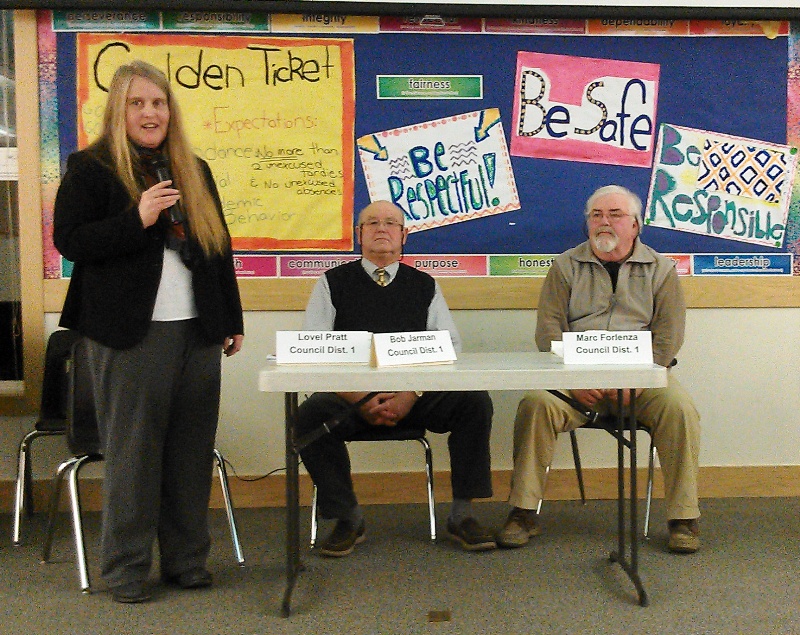Updated Jan. 20 at 6 p.m.
By Margie Doyle
Candidates for Orcas and San Juan Island Council positions presented their points of view at the League of Women Voters forum on San Juan Island last night, Jan. 14.
The League of Women Voters traditionally holds candidate and issue forums before county, state and national elections. Due to the passage of Charter Proposition 1 last November, the County Council will change from six representatives voted upon by their home district, to three representatives (one each from Lopez, Orcas, and San Juan Islands) to be voted upon by the entire county.
The three candidates for each position will be narrowed down to two as a result of the Primary election on Feb. 12. (Lopez Island has only two candidates for the election and so will not be participating in the primary eliminations). Voters will then select their three representative at the April 23, 2013 election.
Greg Ayers, Lisa Byers and Rick Hughes for Orcas; and Marc Forlenza, Bob Jarman and Lovel Pratt for San Juan Island gamely fielded the questions for two hours at the San Juan Middle School auditorium on January 14.
Each candidate gave a three-minute introductory statement before answering questions. (Their introductory comments follow their responses to audience questions in this updated article).
The Questions and Answers: Funding, Economic Growth, Critical Areas Ordinance and Local Gun Control
Early in the forum, the candidates were asked to disclose the money they raised and spent:
Ayers said he’d raised $125 and spent from his own resource; he intended to spend more money because the county-wide nature of the vote means more money needs to be spent
Byers has raised $13,000 from 100 donors, over her budget goal of $10,000. She too said that county-wide costs, especially advertising on all three major islands, were significant.
Hughes has one donor and has raised $250. He personally has spent $3,000 on a mailing, for a total to date of $3,500 spent.
Forlenza said he had $700 remaining from his San Juan district race last November, which he’d spend for mailing cards. He has raised an additional $4,200 from eight donors and spent $746 to-date. He expects to spend $2,000-$3,000 on mailings.
Jarman has raised between $1,000 and $2,000 from two donors. He contributed $1,2000 himself for advertising. Jarman spoke of an injunction stopping the election, and said he was cautious about fundraising.
Pratt has raised $15,000 from 127 supporters, and spent $7,000. She noted that she had been outspent in the November campaigns by 4 to 1 and said campaign funding “does make a difference.
The question was asked as to their recommendations for economic growth:
Hughes advised modifying the code for starting new businesses; welcoming media promotions and broadband technology; working with major corporations to set up research and marketing in the county, and “in the long term l0oking past tourism, construction and real estate.”
Ayers proposed analyzing current ways of using existing infrastructure; promoting cooperative trades such as furniture- and cabinet-making; and expanding agriculture to grow seeds as well as finished crops.
Byers favors examining the role of government in bringing jobs to the county; creating a “regulatory environment and land-use codes where cottage industries can grow; and promoting the islands’ quality of life to the young “millennials” which will increase school enrollment.
Pratt referred to her work in revitalizing the Brickworks building as a permanent, year-found home for the Farmers Market, an example of a “incubator business test market;” she said the passage of GMO-free initiative gives opportunities to farmers to develop seed crops as a commodity; and she praised the council’s work on the wireless ordinance, working with OPALCO to “develop family-wage jobs.”
Jarman spoke of working with the Economic Development Council to develop jobs; he noted that in the past, corporations had failed to develop jobs in the islands because they are “boring;” and that he had “great reservations about seeing 120 towers through the county so we can bring in wireless broadband service.”
Forlenza proposed a “sincere jobs initiative.” He quoted Byers, saying “jobs growth is about quality of life here,” and advised “green development” to create jobs. He advised meeting with large corporations to bring jobs to the county, and starting to develop broadband capabilities through local centers.
When asked for their stance on the Critical Areas Ordinance:
Byers praised the county for adopt the regulations, saying a failure to do so “would have been a failure of leadership.” She said the law “needs tinkering” and that focus on implementation should include individual property owners’ support, accessible information and “predictable and flexible [laws] to the great extent possible.”
Hughes said the county should compile a checklist for property sellers, builders and developers; hold open forum for implementation; analyze and simplify the county code and perhaps make changes to certain sections.
Ayers called the CAO update process “deficient” and advised setting aside the CAO and beginning anew.
Forlenza said he was hopeful the ordinance could be opened again. He described the CAO as overly burdensome and questioned if there were any areas that were threatened or destroyed;
Jarman expects that the March 1 date for implementation would be pushed out and said the community was divided over land-use regulations;
Pratt noted that all 39 Washington counties are required to have a Critical Areas Ordinance, whether they have opted into the Growth Management Act (GMA) or not. As part of the most recent County Council, she said that she saw it as the Council’s responsibility to conclude the update process, noting that the new Council can re-open the matter. She added that the CAO has been “an incredible drain on scarce county resources, time and effort” that could not then be applied to other priorities.
The question about local gun control regulations was asked of both groups:
Byers advocated having a community conversation airing our culture as regards to gun use, and our values as a community;
Hughes brought up the four-date conversation that Orcas Islanders have been invited to have through the leadership of Fred Klein;
Ayers said it was important to fully consider the process: define the issue, collect data, and balance the personal emotions involved in the possibilities of a “loss of freedom or the risk of tragedy.”
The San Juan group was asked more pointedly to give their personal views of the gun control issue.
Forlenza described himself as a supporter of “long guns” for sport and sensible hunting and firmly opposed “weapons that are designed to kill people. They should not be sold.” He also called for “sensible oversight of ‘long guns’ and hand guns.
Jarman, also a recreational “long gun” user, announced his opposition to automatic weapons and assault rifles.
Pratt too supported limitations on gun availability for assault rifle and large-magazine bans. She said it “makes sense for the council to enact local ordinance after a community conversation to identify priorities.” She praised the County, which through its Mental Health Department and support by voters, provides funding for mental-health services. She noted the correlation between mental illness and recent gun assaults.
The Orcas Island Candidates:
- Greg Ayers spoke of his training as a medical doctor and developer of fibrillation technology, his experience building a home for the last five years on Orcas Island, and of his involvement in health issues, including the Island Reproductive Health Initiative and the Eastsound Sewer and Water District.
- Lisa Byers spoke of her commitment to sustain healthy diversity, foster jobs and align the county budget with citizens’ priorities. She has earned a graduate degree in public and non-profit management and has served as Executive Director of the OPAL (Of People and the Land) Community Land Trust for 17 years.
- Rick Hughes spoke of his election last November as Orcas West County Councilman, his past work in outdoor education leadership, sports television and internet ad sales, and his commitment to local solutions for county matters, including a balance between job growth and environmental stewardship.
The San Juan Island Candidates
- Marc Forlenza spoke of his boating leadership with the Power Squadron his revitalization of the derelict vessel program; his support of the assisted living facilities at Village at the Harbor in Friday Harbor, and his part ownership of the Tech Center. He brought up his concerns about jobs and emphasized how difficult it is to make a living in the islands.
- Bob Jarman spoke of his past career with the telephone company, including mapping the islands; and of his commitment to the “islands’ way of life.” He spoke of the need to balance the environment and personal property rights in order to appreciate the rural character of San Juan County.
- Lovel Pratt spoke of past volunteer work as a firefighter, in the schools, with affordable housing and agriculture. She has served for 10 years on the County Planning Commission and from 2008-2012 on the County Council, where she advocated on behalf of the county in matters such as oil spills, ferries, and state and federal funding for essential services.
**If you are reading theOrcasonian for free, thank your fellow islanders. If you would like to support theOrcasonian CLICK HERE to set your modestly-priced, voluntary subscription. Otherwise, no worries; we’re happy to share with you.**










Full disclosure of the Lisa Byers campaign. We have raised close to $15000 and have spent about $12000. As Rick and Greg can both attest, as they are paying for these as well…running a county campaign with online ads, yard signs, websites, and any all-county mailings is expensive. We are fortunate to have so many donors who support Lisa’s message.
All candidates, by law, must file an accurate accounting of donations (made by individuals or the candidates themselves) with the Public Disclosure Commission (PDC). Expenses must also be filled with the 21 days before the primary date of February 12. So, you can review full disclosure of our, and other campaigns donations/expenditures on line at:
https://www.pdc.wa.gov/MvcViewReports/Candidate/loc_candidates
Sorry, should have said within 21 days, not “with 21 days.”
On the topic of local firearms regulation, I would encourage our candidates to familiarize themselves with state law before heading down that path:
https://apps.leg.wa.gov/rcw/default.aspx?cite=9.41.290
RCW 9.41.290
State preemption.
The state of Washington hereby fully occupies and preempts the entire field of firearms regulation within the boundaries of the state, including the registration, licensing, possession, purchase, sale, acquisition, transfer, discharge, and transportation of firearms, or any other element relating to firearms or parts thereof, including ammunition and reloader components. Cities, towns, and counties or other municipalities may enact only those laws and ordinances relating to firearms that are specifically authorized by state law, as in RCW 9.41.300, and are consistent with this chapter. Such local ordinances shall have the same penalty as provided for by state law. Local laws and ordinances that are inconsistent with, more restrictive than, or exceed the requirements of state law shall not be enacted and are preempted and repealed, regardless of the nature of the code, charter, or home rule status of such city, town, county, or municipality.